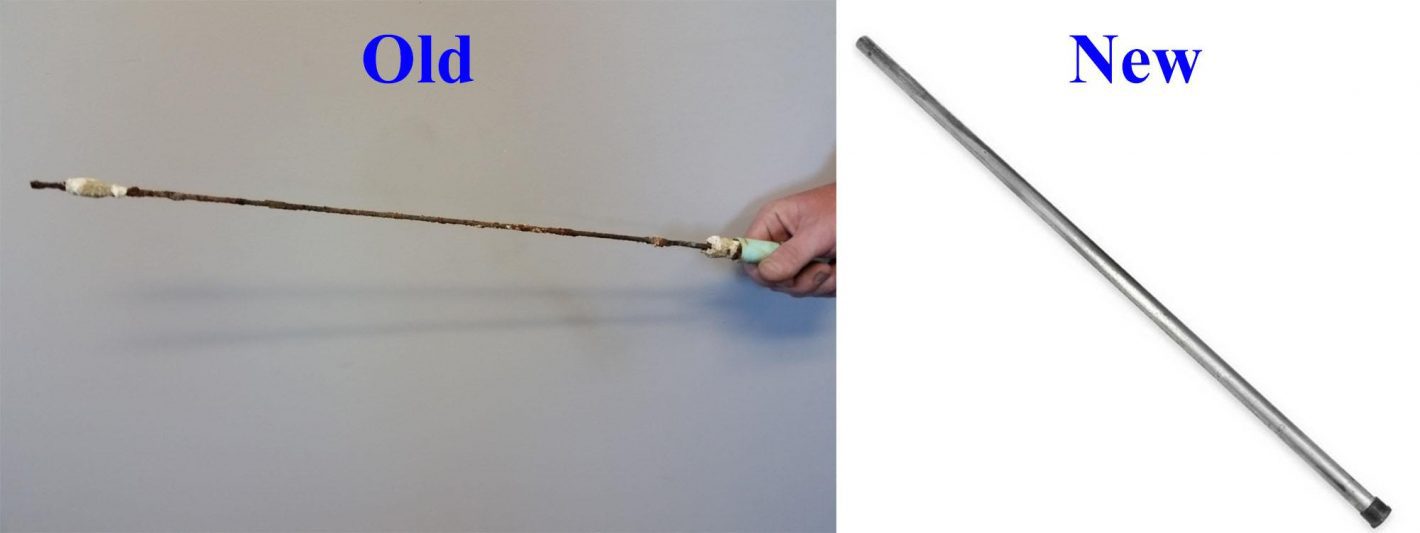2 Tips to Save Your Water Heater
Home >
What if I told you that a simple metal rod is the single most important factor in determining the lifespan of your tanked water heater? What if I said that this rod protects the inside of your tank from rusting, and therefore leaking, and that it could prevent catastrophic failure and significant water damage?
An anode rod is a steel wire surrounded with aluminum, magnesium, or zinc. The rod is screwed into the top of your water heater and protects your water heater from rusting from the inside. You can see what an anode rod should look like in the images below, versus what we often find in our customer’s systems.

Basically, when two metals are placed together in water, the less reactive (nobler) will remain intact, while the more reactive metal of the anode rod corrodes; the chemical reaction protects your water heater against the process of oxidation by attracting elements to the anode rod rather than to any exposed bits of steel. Even though you may have never heard of an anode rod, this technology has been around for a long time. They’re widely used in the maritime industry to protect boats from rusting, for instance.
But isn’t my water heater lined?
Nearly all water heater tanks are made of steel with a glass lining to protect them from rusting, but linings eventually crack, so anode rods provide a secondary defense. Once an anode rod is corroded, it stops working, and your water heater jumps on the fast track to failure.
The anode rod, when replaced regularly per manufacturers’ specifications, slows down corrosion inside water heater tanks and significantly extends equipment lifespan. You may want to take a look at your owner’s manual to see how frequently your anode rod needs to be replaced. If you can’t find the manual or are unsure what brand of water heater you have, feel free to give Sanford Temperature Control a ring.
What else can I do to keep my water heater healthy?
Having the anode rod replaced isn’t the only thing you can do to keep your water heater operating at peak performance. Unfortunately, the water coming into your home isn’t always as pure as we’d like it to be. On average, your water heater gains about 3 pounds of sediment every year, cutting down on the efficiency and heating capacity of your water heater. Sediments such as calcium carbonate and sand buildup in your water heater and settle at the bottom of the tank, which overheats the tank bottom, weakens the steel, and damages the glass lining.
A flush and clean of your system can help avoid water heater burn out, the buildup of corrosive anaerobic bacteria in your water (yuck!), clogged lines, failing pumps and more. The flush and clean is another way to avoid catastrophic water heater failure.
So, if your anode rod looks anything like the one we recently removed from a customer’s water heater, or if this is the first time you’ve even heard of an anode rod, or if you can’t even remember the last time you had your water heater serviced, you’ll probably want to check into water heater service soon.


Adrian W.
Marketing Manager
CONTACT US TODAY



As Seen & Heard On







Reach Out to Our Team for More Details
Feel free to call Sanford Temperature Control or fill out the online form for more information. You may also get in touch with our team to schedule an appointment. We look forward to hearing from you.

